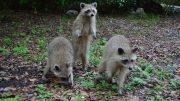Stephanie Feldman/Contributing Writer
With a variety of physical landscapes from mangroves to beaches, the Biscayne Bay Campus serves as a home for some of Florida’s most treasured species. Its location alongside Oleta River State Park provides a lush landscape and habitat for hundreds of native species.
But one bird has environmental science students excited: the wood stork. This rare bird is one of the only storks that breed in the United States and is considered to be threatened due to the destruction of shallow wetlands such as the ones that surround BBC. Making its home alongside other migrating birds, the wood stork’s presence indicates the health of the environment on campus.
Students at the School of Environment, Arts and Society plan to keep it that way.
According to Jennifer Grimm, the environmental programs manager at the School of Environment, Arts and Society, students and staff have engaged in several important projects to help restore and conserve the environment. One project that is currently taking place is a massive wetland and mangrove forest restoration project. Mangrove forests can include various species of trees and shrubs that grow in the water near coasts and estuaries. These trees, with their complex root system, can tolerate salt and brackish water, and provide safe havens for young creatures such as shrimp, oysters, fish, even baby sharks.
In addition to the protection of animals, mangroves serve as “natural buffers” shielding coastal areas from erosion and storm surges, very important during Florida’s many hurricanes. The project, which will in part be aided by volunteers, hopes to restore about 15 acres of land on the BBC campus. Their work will consist of helping to remove invasive species, planting the mangroves, exploring other wildlife restoration projects such as maintaining and planting in the butterfly gardens and working in the greenhouse.
The campus’ many ponds and mangrove forests provide hunting grounds for many Florida species such as Anhinga birds, which can completely immerse themselves in water as they dive and search out food, but are often seen drying their feathers in the sun. Snowy egrets and blue heron are also commonly seen in the pond between the Wolfe University Center and Marine Science Buildings.
The beaches around the campus also provide homes for a vast number of aquatic animals. It is not uncommon to see crabs scurrying around the shoreline or even manatees and dolphins. Several butterfly gardens have also been constructed throughout campus. Floating above native flower species, one can see beautiful orange and black monarch and queen monarch butterflies and even threatened species such as the Atala butterfly. Other insects commonly seen around campus include the banana spider which can weave a twelve foot wide web in just one night.
According to Grimm, all plants and animals regardless of size are vital as “each one of them has a very important role in keeping the food web and ecosystem in check.”
She hopes that by turning the focus on Florida’s native species, like those found on and around campus, students and researchers will help find new ways to study and conserve wildlife as well help to highlight FIU’s environmental initiatives.






Be the first to comment on "SEAS works on improving natural habitats"